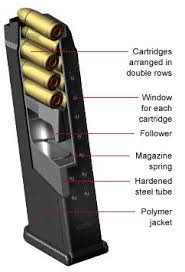I often get questions from readers and students about firearms maintenance. Recently I was questioned concerning how long one could keep a pistol magazines loaded without damaging the springs?
This is one of the classic questions sure to start a bar fight amongst firearms enthusiasts, and ranks right up there with “Which is better a Glock or a Colt 1911”?
The correct answer is: “It depends”
It depends on what type of magazine: single stack or double stack, how often you use the magazine and the capacity of the magazine. In general, using a mag is what wears the springs out. If you only have two magazines and go to the range every week then you are doing a whole lot of loading and unloading of those mags. This will wear them out long before they lose tension from sitting loaded for “X” number of years.
We have all heard tales of the person who found their Great-Grandfather’s WWI Colt 1911 in a chest with a loaded magazine and it fired just fine. I believe this because the 1911 uses a single stack magazine and the springs are generally not very stressed. In a single stack magazine all the rounds are in a straight line with very little drag between the cartridges and the walls of the magazine.
In a modern high capacity magazine the rounds are staggered in a wider magazine. This is necessary to get 12 – 17 rounds in the length of a pistol grip. The spring pushing the cartridges up is also forcing the rounds outwards against the side of the magazine. This increased drag makes the spring work harder to force the ammunition upward putting more stress on the spring causing it to fatigue at a faster rate. Unloading these magazines a round or two will help the life of the spring.
Magazines which are kept fully loaded for long periods of time, such as in law enforcement and personal/home defense applications, will generally be subject to more fatigue than the weekend shooter’s magazine springs in which the magazines are loaded up only when shooting. If you have several magazines rotating fully loaded magazines will also help prolong spring life, but it is not always practical.
The reason we are talking about this is reliability. The first indication of a magazine problem usually shows up as a failure to feed correctly. I have several semi-auto pistols that are over 20 years old and although they were still functioning correctly, I did notice one mag that was very easy to load versus newer ones of the same type.
If one of your magazine springs seems weak when loading, replacement will provide the best defense against a reliability problem with your gun. Springs are available from gun stores, the pistol manufacturer, or from on-line suppliers. They are inexpensive to purchase, ranging from $8 -$10 when purchased individually, to less than $5 each in packs of ten. Premium replacements spring are available in +5% and +10% strengths as well as in stainless steel to reduce the potential for corrosion.
People often overlook magazine maintenance when cleaning their guns. Magazines are prone to picking up dirt and sand when they are placed on tables at ranges or dropped to the ground while practicing tactical magazine changes. Periodically you should remove the floor-plate from your magazine and take out the spring and follower. Check the spring and the inside of the magazine for corrosion, wipe out any debris and reassemble the mag. I always reassemble my magazines dry, and never apply any oil or lube as it tends to attract dirt and dust that may lead to feed issues.


